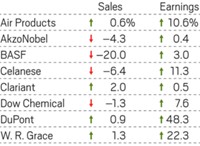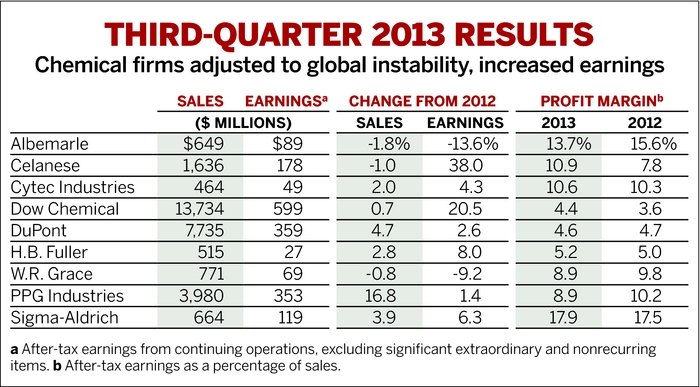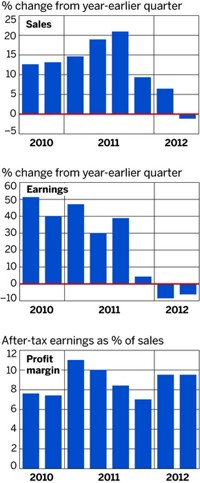Advertisement
Grab your lab coat. Let's get started
Welcome!
Welcome!
Create an account below to get 6 C&EN articles per month, receive newsletters and more - all free.
It seems this is your first time logging in online. Please enter the following information to continue.
As an ACS member you automatically get access to this site. All we need is few more details to create your reading experience.
Not you? Sign in with a different account.
Not you? Sign in with a different account.
ERROR 1
ERROR 1
ERROR 2
ERROR 2
ERROR 2
ERROR 2
ERROR 2
Password and Confirm password must match.
If you have an ACS member number, please enter it here so we can link this account to your membership. (optional)
ERROR 2
ACS values your privacy. By submitting your information, you are gaining access to C&EN and subscribing to our weekly newsletter. We use the information you provide to make your reading experience better, and we will never sell your data to third party members.
Business
Chemical Industry Locks In Recovery
Another quarter of strong sales and earnings gives chemical executives reasons to be confident
by Melody Voith
November 15, 2010
| A version of this story appeared in
Volume 88, Issue 46

For U.S. chemical firms, the third quarter brought evidence that the economic recovery, which seemed wobbly in the second quarter, is gaining traction. For the 22 firms tracked by C&EN, sales rose 12.6% and earnings shot up a healthy 51.2% compared with last year’s third quarter.
The results mark two quarters in a row with strong sales and earnings for the chemical industry. Although most firms still relied on the emerging economies of Asia to provide much of their revenue growth, the economic recovery finally started spreading to the developed regions of North America and Europe.
Dow Chemical is “encouraged to see signs of improved growth in North America and Europe, especially Germany, which point toward increased momentum in the developed regions,” Chief Executive Officer Andrew N. Liveris wrote in a note to investors. “Many of Dow’s major end markets—such as electronics, coatings, automotive, and packaging, amongst others—continue to show strength, despite ongoing headwinds from high unemployment and continued weakness in construction spending.”
A year ago, chemical firms were reporting the first upward blips of demand in some emerging markets after four quarters of contraction. But it wasn’t until this year’s second quarter that real evidence of recovery for chemicals emerged. Executives focused on the strong demand for electronic materials in Asia, where factories started churning out solar panels and consumer electronics. In addition, most firms saw at least modest general improvements in sales volumes in the second quarter.
In July, chemical executives had warned that the second quarter’s victories might be temporary. But in third-quarter reports, they sound relieved, and a bit surprised, to mark another period of growth.
Dow held steady with earnings of $705 million, compared with $707 million in the second quarter. The results were close to double what the firm posted in last year’s third quarter.
Dow significantly increased sales compared with last year in all of its business segments and beat most analysts’ earnings expectations. It sold more than $2.6 billion in its performance products business, its largest segment for the quarter, even though it sold off Styron, one of its large performance businesses. Goldman Sachs chemicals analyst Robert Koort wrote in a report to clients that “despite the Styron divestiture, the performance products segment grew sales 9% versus our expectation for a decline.”
Also going strong was Dow’s plastics business, which brought in another $2.6 billion in revenue. Dow has been expected to sell some or all of its plastics business after a planned Kuwaiti joint venture fell through. At a recent press conference, Liveris said he is considering keeping linear low-density polyethylene and finding a partner or buyer for polypropylene and high-density polyethylene (C&EN, Nov. 8, page 11).
Overall, the increased sales—and a cost structure trimmed during the recession—boosted Dow’s quarterly profit margin to 5.5% from 3.0% in the year-ago quarter and 5.2% in the second quarter of 2010.
Together, the 22 firms tracked by C&EN racked up a profit margin of 7.6%, a huge increase from last year’s third-quarter margin of 5.6%. Of the group, 13 saw profit margins increase from the second quarter of 2010.
But not all companies saw margins expand compared with last year. Although Ashland saw an increase in sales of 12.7%, its profit margin stayed in the basement at 3.5%.
“It was a very challenging quarter. Despite double-digit sales growth, raw material cost pressures continued to temper margins,” Ashland CEO James J. O’Brien explained in a note to investors. “Our businesses continue to implement price increases, where appropriate, to offset raw material inflation, but as we’ve said before, it can take, on average, three to four months to fully recover costs.”
Indeed, rising raw material costs are the next hurdle awaiting chemical companies, said Tim Hanley, process and industrial products practice leader at business consultancy Deloitte. “Companies will have to balance when they can increase prices, while making sure not to miss opportunities in increasing demand. By focusing on a specific product line, they must very carefully make sure they can get price increases passed along.” Although the recovery is still gathering steam, Hanley added, “energy prices and commodity prices have already been going up.”
DuPont told analysts that it expects raw material costs in 2010 to be up 5–6%, more than the 3% it had predicted earlier. The company also took a hit on its earnings and profit margin for the quarter because of pharmaceutical patent expirations. Still, sales were up 17.4% from last year to just over $7 billion.
Performance chemicals were particularly strong for DuPont in the third quarter, with sales up 25.8% compared with the year-ago quarter. The company told analysts that titanium dioxide drove much of the increase in revenue and that demand continues to exceed supply in the market for the white pigment. CEO Ellen J. Kullman earlier told C&EN it was a notable decrease in demand for TiO2 in 2008 that foreshadowed the recession’s impact on DuPont and triggered sharp cost cutting (C&EN, April 12, page 10).
At Eastman Chemical, CEO James P. Rogers was able to boast about achieving a second consecutive quarter of record earnings per share. In a note to investors, the company attributed its 29.3% growth in sales to “end-use demand in packaging, durable goods, and other markets and the positive impact of growth initiatives.” The growth enabled the firm to boost earnings by 68.3% compared with last year’s third quarter.
An increase in demand for industrial coatings powered PPG Industries to a 64.0% increase in earnings over the third quarter of 2009. “Higher industrial activity resulted in sizable gains in our industrial coatings and commodity chemicals segments and in our fiber glass business, all of which are experiencing strong demand recovery from the recession,” CEO Charles E. Bunch remarked. Overall, the company said, the strong results were thanks to volume growth in emerging regions because construction markets in the developed world were “anemic.”
In the U.S., there are some glimmers of hope that construction will pick up. The National Association of Home Builders says builder confidence in the market for new single-family homes has increased for the first time in five months. “The new-homes market is finally moving past the lull that occurred when the home buyer tax credits expired and economic growth stalled this summer,” NAHB Chief Economist David Crowe noted in a statement. “The toughest obstacles really come down to financing—the scarcity of construction credit for builders along with tougher mortgage requirements for consumers.”
U.S. consumer and business spending has been inching up in 2010, according to the government’s Bureau of Economic Analysis. Consumer spending on durable goods—an important signal for the chemical industry—increased 6.1% from the second quarter. And private businesses increased inventories $115.5 billion in the third quarter, following increases of $68.8 billion in the second quarter and $44.1 billion in the first quarter.
But compared with the U.S. economy—where gross domestic product (GDP) increased only 2.0% in the third quarter—China’s growth shows why it is the preferred market for chemical producers. According to China’s National Bureau of Statistics, the country’s GDP grew 11.9% in the first quarter, 10.3% in the second quarter, and 9.6% in the third quarter.
Deloitte’s Hanley said chemical and other manufacturing executives will continue to keep a close eye on what happens in the Chinese economy. “It had such a quick bounce back from the recession, now it has a new five-year plan from the government.” It’s up to U.S.-based businesses to make sure they meet China’s growing demand, he suggests. “If there’s one theme from the manufacturing industry, it’s the exports. The numbers show the strength of the export market and that it’s having a positive impact on domestic production.”
Dow’s Liveris told investors he is closely watching China, as well as a number of other economies. “Our view is that robust growth in emerging economies will continue as domestic demand in faster growing geographies such as Brazil, Asia, Middle East, and Eastern Europe is further strengthening,” particularly in markets such as infrastructure, transportation, and packaging.
Liveris hasn’t given up on North America and Europe, however. “We expect growth in the developed world will be at a slightly lower rate than experienced in the first half of the year. Importantly, it is growth nonetheless,” he said.







Join the conversation
Contact the reporter
Submit a Letter to the Editor for publication
Engage with us on Twitter